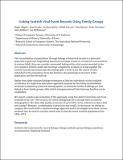Linking Scottish vital event records using family groups
View/
Date
02/04/2020Author
Grant ID
ES/L007487/1
ES/K00574X/2
Keywords
Metadata
Show full item recordAbstract
The reconstitution of populations through linkage of historical records is a powerful approach to generate longitudinal historical microdata resources of interest to researchers in various fields. Here we consider automated linking of the vital events recorded in the civil registers of birth, death and marriage compiled in Scotland, to bring together the various records associated with the demographic events in the life course of each individual in the population. From the histories, the genealogical structure of the population can then be built up. Rather than apply standard linkage techniques to link the individuals on the available certificates, we explore an alternative approach, inspired by the family reconstitution techniques adopted by historical demographers, in which the births of siblings are first linked to form family groups, after which intergenerational links between families can be established. We report a small-scale evaluation of this approach, using two district-level data sets from Scotland in the late nineteenth century, for which sibling links have already been created by demographers. We show that quality measures of up to 83% can be achieved on these data sets (using F-Measure, a combination of precision and recall). In the future, we intend to compare the results with a standard linkage approach and to investigate how these various methods may be used in a project which aims to link the entire Scottish population from 1856 to 1973.
Citation
Akgün , Ö , Dearle , A , Kirby , G N C , Garrett , E , Dalton , T S , Christen , P , Dibben , C J L & Williamson , L E P 2020 , ' Linking Scottish vital event records using family groups ' , Historical Methods: a Journal of Quantitative and Interdisciplinary History , vol. 53 , no. 2 , pp. 130-146 . https://doi.org/10.1080/01615440.2019.1571466
Publication
Historical Methods: a Journal of Quantitative and Interdisciplinary History
Status
Peer reviewed
ISSN
0161-5440Type
Journal article
Description
Funding: This work was supported by ESRC Grants ES/K00574X/2 “Digitising Scotland” and ES/L007487/1 “Administrative Data Research Centre – Scotland.”Collections
Items in the St Andrews Research Repository are protected by copyright, with all rights reserved, unless otherwise indicated.

